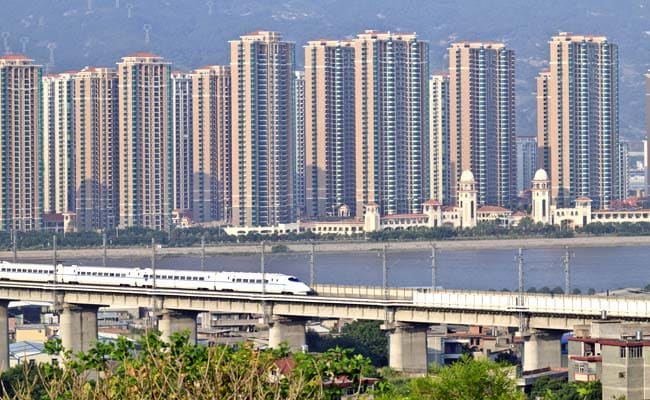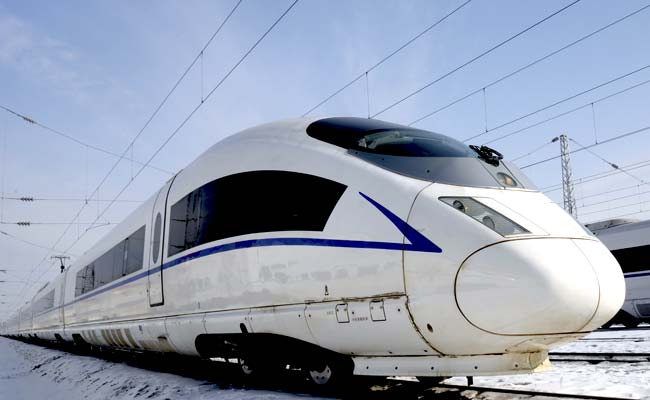
The loop high-speed railway (HSR) is interconnected with crisscrossed highways and ports, greatly improving the public transport infrastructure on Hainan island. (Photo: China High Speed Railway)
Haikou, China:
The unique circular high-speed railway in China's Hainan Island, the world's first such train around a tropical zone, has been operating smoothly since last year, braving extreme weather conditions.
Considering the characteristics of high temperature, high humidity and strong corrosion on the tropical island, a number of new technologies, materials and techniques have been used in the construction of the 653-km rail belt.
"These include integral cantilever endurable to typhoon, fastening system with preservative treatment by the latest technologies, unique designs in lightning protection and earthquake prevention, endurable to magnitude 8 earthquake," said Mehg Wei Hua, Vice General Manager of Guangzhou Railway group, China Railways.
"During typhoon period, every 10 km we have one weather observation point checking wind direction, wind power and we take the measures to control the speed accordingly," he told journalists onboard the high-speed train from Haikou, the capital of the island province of Hainan, to Sanya, a tropical tourist spot located at the southernmost point of China's railway network.

The non-stop train completed nearly 300 kms of its journey in a little over 80 minutes.
The 653-km rail belt connects Haikou in the north to Sanya in the south. It consists of east loop section and west loop section with trains running along both the sides with 25 stations along the way as part of its unique loop design.
Mehg Wei said that the east section of the loop railway with a total length of 308 km and the design speed of 250 kmph started construction in September 2007 and became operational in December, 2010 while the west section with a total length of 345 kms and the design speed of over 200 kmph started construction in September 2013 and began operation in December, 2015.
The loop high-speed railway (HSR) is interconnected with crisscrossed highways and ports, greatly improving the public transport infrastructure on Hainan island as an international tourism spot, he said.

Mehg Wei said after the HSR was built, it has helped change the lives of the people living on the island.
Hainan Island circlular HSR is located to the south of the Tropic of Cancer. With a tropical climate on this island, there are plenty of rainfall along the line with the average rainfall up to 1,759.8 mm.
At present the number of electric multiple unit (EMU) run every day is 43 pairs.
Meanwhile, the China Railway officials said that the passengers can get or order high-speed train tickets easily at manual ticketing windows in stations, self-service ticketing machines, ticket agencies, or through voice call, mobile App or the website of the China Railway Customer Service Centre.
China's high-speed EMU trains are equipped with high-speed bogies with excellent vibration-damping performance to reduce inside vibration and noise, they said.
The high-speed railways are fully-fenced and equipped with advanced safety monitoring system and complete prevention and rescue measures against disasters; which can timely identify and deal with natural disasters and emergencies such as heavy wind, rain, ice, snow and earthquake.
Also, multiple energy-saving technologies including new type of materials and intelligent technologies are adopted in the development of high-speed railway stations.
The construction and operation of high-speed railways have boosted the development of industries such as metallurgy, machinery, construction, rubber, power, information, computer and precise meters, the officials pointed out.
High-speed trains have cut travel time drastically. For example, a distance of 2,298 km from Beijing to Guangzhou is covered in eight hours from earlier nearly 21 hours and Beijing-Shanghai (1,318 km) is now covered in 4 hours and 48 minutes.
Likewise, in northeast China, Changchun-Shenyang's 298-km distance is covered in 1 hour; in north China Beijing-Tianjin's 120-km distance is covered in 33 minutes, in Central China, Zhengzhou-Wuhan's 536-km in 1 hour and 44 minutes.
Considering the characteristics of high temperature, high humidity and strong corrosion on the tropical island, a number of new technologies, materials and techniques have been used in the construction of the 653-km rail belt.
"These include integral cantilever endurable to typhoon, fastening system with preservative treatment by the latest technologies, unique designs in lightning protection and earthquake prevention, endurable to magnitude 8 earthquake," said Mehg Wei Hua, Vice General Manager of Guangzhou Railway group, China Railways.
"During typhoon period, every 10 km we have one weather observation point checking wind direction, wind power and we take the measures to control the speed accordingly," he told journalists onboard the high-speed train from Haikou, the capital of the island province of Hainan, to Sanya, a tropical tourist spot located at the southernmost point of China's railway network.

A distance of 2,298 km from Beijing to Guangzhou is covered in eight hours from earlier nearly 21 hours and Beijing-Shanghai (1,318 km) is now covered in 4 hours and 48 minutes. (Photo: China High Speed Rail)
The non-stop train completed nearly 300 kms of its journey in a little over 80 minutes.
The 653-km rail belt connects Haikou in the north to Sanya in the south. It consists of east loop section and west loop section with trains running along both the sides with 25 stations along the way as part of its unique loop design.
Mehg Wei said that the east section of the loop railway with a total length of 308 km and the design speed of 250 kmph started construction in September 2007 and became operational in December, 2010 while the west section with a total length of 345 kms and the design speed of over 200 kmph started construction in September 2013 and began operation in December, 2015.
The loop high-speed railway (HSR) is interconnected with crisscrossed highways and ports, greatly improving the public transport infrastructure on Hainan island as an international tourism spot, he said.

The high-speed railways are equipped with advanced safety monitoring system which can timely identify and deal with natural disasters and emergencies such as heavy wind, rain, ice, snow and earthquake.
Mehg Wei said after the HSR was built, it has helped change the lives of the people living on the island.
Hainan Island circlular HSR is located to the south of the Tropic of Cancer. With a tropical climate on this island, there are plenty of rainfall along the line with the average rainfall up to 1,759.8 mm.
At present the number of electric multiple unit (EMU) run every day is 43 pairs.
Meanwhile, the China Railway officials said that the passengers can get or order high-speed train tickets easily at manual ticketing windows in stations, self-service ticketing machines, ticket agencies, or through voice call, mobile App or the website of the China Railway Customer Service Centre.
China's high-speed EMU trains are equipped with high-speed bogies with excellent vibration-damping performance to reduce inside vibration and noise, they said.
The high-speed railways are fully-fenced and equipped with advanced safety monitoring system and complete prevention and rescue measures against disasters; which can timely identify and deal with natural disasters and emergencies such as heavy wind, rain, ice, snow and earthquake.
Also, multiple energy-saving technologies including new type of materials and intelligent technologies are adopted in the development of high-speed railway stations.
The construction and operation of high-speed railways have boosted the development of industries such as metallurgy, machinery, construction, rubber, power, information, computer and precise meters, the officials pointed out.
High-speed trains have cut travel time drastically. For example, a distance of 2,298 km from Beijing to Guangzhou is covered in eight hours from earlier nearly 21 hours and Beijing-Shanghai (1,318 km) is now covered in 4 hours and 48 minutes.
Likewise, in northeast China, Changchun-Shenyang's 298-km distance is covered in 1 hour; in north China Beijing-Tianjin's 120-km distance is covered in 33 minutes, in Central China, Zhengzhou-Wuhan's 536-km in 1 hour and 44 minutes.
Track Latest News Live on NDTV.com and get news updates from India and around the world

